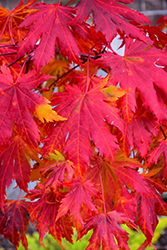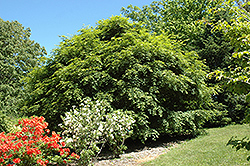Height: 20 feet
Spread: 15 feet
Sunlight:
![]()
![]()
Hardiness Zone: 4
Other Names: Purplebloom Maple
Description:
The ideal substitute for the coveted Japanese maples where they are not hardy, with similary fingered leaves, attractive tiered growth habit and shocking fall colors of yellow, orange, scarlet and red; does best in cool, moist conditions; use as an accent
Ornamental Features
Korean Maple is primarily valued in the landscape for its ornamental globe-shaped form. It features subtle clusters of creamy white flowers with purple bracts rising above the foliage in early spring before the leaves. It has attractive forest green deciduous foliage which emerges red in spring. The palmate leaves are highly ornamental and turn an outstanding scarlet in the fall. The rough gray bark and brick red branches add an interesting dimension to the landscape.
Landscape Attributes
Korean Maple is an open multi-stemmed deciduous tree with a more or less rounded form. Its average texture blends into the landscape, but can be balanced by one or two finer or coarser trees or shrubs for an effective composition.
This is a relatively low maintenance tree, and should only be pruned in summer after the leaves have fully developed, as it may 'bleed' sap if pruned in late winter or early spring. It has no significant negative characteristics.
Korean Maple is recommended for the following landscape applications;
- Accent
- Mass Planting
- General Garden Use
Planting & Growing
Korean Maple will grow to be about 20 feet tall at maturity, with a spread of 15 feet. It has a low canopy with a typical clearance of 2 feet from the ground, and is suitable for planting under power lines. It grows at a medium rate, and under ideal conditions can be expected to live for 70 years or more.
This tree does best in full sun to partial shade. It prefers to grow in average to moist conditions, and shouldn't be allowed to dry out. It is not particular as to soil type or pH. It is somewhat tolerant of urban pollution, and will benefit from being planted in a relatively sheltered location. Consider applying a thick mulch around the root zone in winter to protect it in exposed locations or colder microclimates. This species is not originally from North America.


